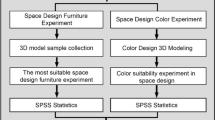Abstract
When designing an interior space, it is expected to consider not only the functions required for the space but also the emotions desired by the users in the space. Color plays an important role in evoking specific emotions. There are many studies that have investigated the effect of color on emotion and the effect of color in interior spaces on emotion. However, the difference between the effect of color on emotion and the effect of space color on emotion has not been sufficiently investigated and is not clear. In this study, to clarify the effect of color on emotion in interior spaces, we evaluated the difference in the effect of the same color on emotion with and without furniture using physiological indexes and a questionnaire. As a result, the physiological indexes showed that viewing spatial design images was more comfortable than viewing plain color images, and the arousal level was higher when viewing interior spatial design images. In addition, a comparison between hues showed the same tendency for plain color and spatial design images. The questionnaire evaluation showed that spatial design images and plain color images of the same color gave similar impressions. Thus, spatial design images and plain color images tended to be similar in hue comparison. Therefore, it is possible that the effect of color on emotion has the same effect on spatial design.
Access this chapter
Tax calculation will be finalised at checkout
Purchases are for personal use only
Similar content being viewed by others
References
Ćurĉić, A., Kekovic, A., Ranđelović, D., Momcilovic-Petronijevic, A.: Effects of color in interior design. Zbornik radova Građevinskog fakulteta 35, 867–877 (2019)
Yukie, K.R., Hashimoto, Isamu, A.: Psychological and physiological responses to color of a room. J. Color Sci. Assoc. Jpn. 28(1), 16–25 (2004)
Enwin, A.D., Ikiriko, T.D., Jonathan-Ihua, G.O.: The role of colours in interior design of liveable spaces. EJTAS 1(4), 242–262 (2023)
Valdez, P., Mehrabian, A.: Effects of color on emotions. J. Exp. Psychol. Gen. 123(4), 394–409 (1994)
Yildirim, K., Hidayetoglu, M.L., Capanoglu, A.: Effects of interior colors on mood and preference: comparisons of two living rooms. Percept. Mot. Skills. 112(2), 509–524 (2011)
Takehiro, K., Ryota, Y.: Effect of all color and wooden floor on the impression and apparent size in living space. J. Architect. Build. Scie. 24(57), 747–750 (2018)
Osgood, C.E., Suci, G.H., Tannenbaum, P.H.: The Measurement of Meaning. University of Illinois Press, Chicago (1957)
Stevens, S.S.: Psychophysics: Introduction to Its Perceptual Neural and Social Prospects. John Wiley, New York (1975)
Ikeda, Y., Sugaya, M.: Estimate emotion method to use biological, symbolic information preliminary experiment. In: Schmorrow, D.D.D., Fidopiastis, C.M.M. (eds.) AC 2016. LNCS (LNAI), vol. 9743, pp. 332–340. Springer, Cham (2016). https://doi.org/10.1007/978-3-319-39955-3_31
Wilms, L., Oberfeld, D.: Color and emotion: effects of hue, saturation, and brightness. Psychol. Res. 82(8), 96–914 (2018)
Katayama, l., Zhang, X., Aoki, T.: Application of coior appearance model to coior lmage evaluation. Trans. Jpn. Soc. Interior Stud. 12, 3 (2002)
Kazumichi, H., Aya, T.: Playing with colors using watercolors by four psychological primary colors -for understanding color of donor. Res Bullet. Kindai Univ. Kyushu Jr. 48, 136–143 (2018)
Voice of Colour. https://www.visualizecolor.com/. Accessed 23 May 2023
Khosla, et al.: A comparative analysis of signal processing and classification methods for different applications based on EEG signals. Biocybernet. Biomed. Eng. 40(2), 649–690 (2020)
Ueno, S., Zhang, R., Laohakangvalvit, T., Sugaya, M.: Evaluating comfort in fully autonomous vehicle using biological emotion map. In: Stanton, N. (ed.) AHFE 2021. LNNS, vol. 270, pp. 323–330. Springer, Cham (2021). https://doi.org/10.1007/978-3-030-80012-3_38
James, A., Russell, A.: Circumplex model of affect. J. Pers. Soc. Psychol. 39(6), 1161–1178 (1980)
Suzuki, K., Laohakangvalvit, T., Matsubara, R., Sugaya, M.: Constructing an emotion estimation model based on EEG/HRV indexes using feature extraction and feature selection algorithms. Sensors 21(9), 2910 (2021)
Dzedzickis, A., Kaklauskas, A., Bucinskas, V.: Human emotion recognition: review of sensors and methods. Sensors (Basel) 20, 592 (2020)
Eoh, H.J., Chung, M.K., Kim, S.-H.: Electroencephalographic study of drowsiness in simulated driving with sleep deprivation. Int. J. Ind. Ergon. 35, 307–320 (2005)
NeuroSky, MindWave Mobile. http://store.neurosky.com/. Accessed 20 June 2023
Nafea, M., Hisham, A.B., Abdul-Kadir, N.A., Harun, F.K.C.: Brainwave-controlled system for smart home applications. In: 2018 2nd International Conference on BioSignal Analysis, Processing and Systems (ICBAPS), pp. 75–80. IEEE (2018)
PulseSensor. https://pulsesensor.com/. Accessed 20 June 2023
Author information
Authors and Affiliations
Corresponding author
Editor information
Editors and Affiliations
Rights and permissions
Copyright information
© 2024 The Author(s), under exclusive license to Springer Nature Switzerland AG
About this paper
Cite this paper
Ninomiya, S., Jadram, N., Sugaya, M. (2024). Investigation of a Method for Evaluating the Effect of Interior Colors on Emotions. In: Stephanidis, C., Antona, M., Ntoa, S., Salvendy, G. (eds) HCI International 2024 Posters. HCII 2024. Communications in Computer and Information Science, vol 2114. Springer, Cham. https://doi.org/10.1007/978-3-031-61932-8_35
Download citation
DOI: https://doi.org/10.1007/978-3-031-61932-8_35
Published:
Publisher Name: Springer, Cham
Print ISBN: 978-3-031-61931-1
Online ISBN: 978-3-031-61932-8
eBook Packages: Computer ScienceComputer Science (R0)




